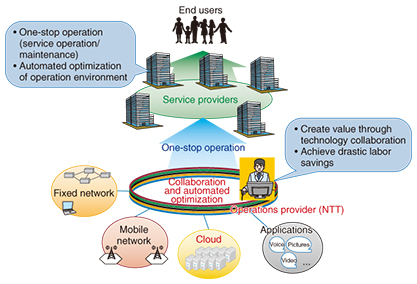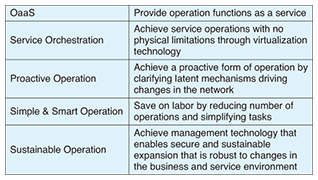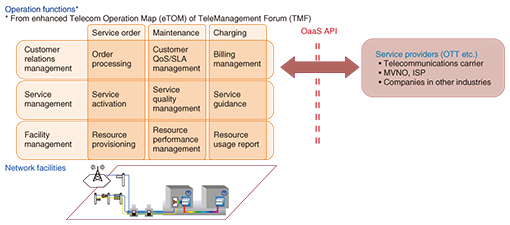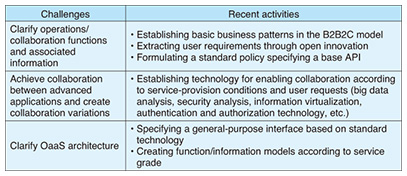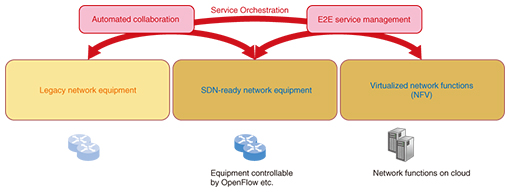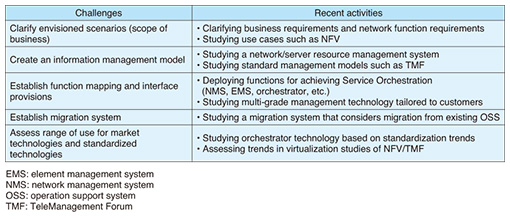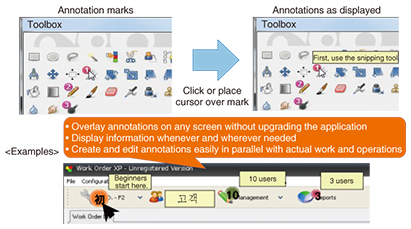 |
|||||||||||||
|
|
|||||||||||||
|
Feature Articles: NTT Tsukuba Forum 2014 Workshop Lectures Vol. 13, No. 3, pp. 65–70, Mar. 2015. https://doi.org/10.53829/ntr201503fa11  NTT R&D Activities toward Future Access Network OperationAbstractThe Access Network Operation Project of NTT Access Network Service Systems Laboratories is a research and development (R&D) undertaking targeting a future operation system in the access network. This article provides an overview of access network operation in a future network slated for implementation around 2020 and describes related R&D activities. It also introduces various R&D efforts focused on the use of navigation technology for streamlining the execution of business operations without affecting the existing operation system. Keywords: future operations, future networks, navigation technology 1. IntroductionOn May 13, 2014, NTT President and CEO Hiroo Unoura announced in a press conference that NTT EAST and NTT WEST would begin wholesaling fiber access services. By providing these services in a fair manner to a wide variety of market players in diverse industries, NTT is advancing a Hikari Collaboration Model [1] that signals a radical shift from its existing B2C (business-to-consumer) business to B2B2C (business-to-business-to-consumer) business. In this model, players such as telecommunication carriers, mobile virtual network operators (MVNOs), and Internet service providers (ISPs) provide services linking fixed and mobile communications. For example, the Hikari Collaboration Model could be applied to a total health support service in which medical institutions provide remote diagnosis and health consultations, electronics manufacturers provide devices for health monitoring, and fitness clubs suggest exercise plans for their members. In this way, market players in a wide range of industries collaborate to provide one-stop services supporting a healthy lifestyle. The target access network operation scenario needed in order to achieve this B2B2C model based on the wholesaling of fiber access services is shown in Fig. 1. In this scenario, NTT will be an operations provider for service providers, who are represented by the second “B” in the B2B2C model. NTT will provide, in particular, one-stop operation and maintenance of network, cloud, and application services. This one-stop operation can contribute to the creation of new and attractive services in a wide variety of industries. Furthermore, end users in this scenario will be able to select from a variety of innovative services provided by diverse market players. At the same time, the operations provider (NTT), represented by the first “B” in the B2B2C model, must be capable of supporting diverse service levels and responding quickly to a huge number of service applications, so substantial labor savings will be needed to provide operations in this model.
NTT Access Network Service Systems Laboratories is currently examining five future directions of access network operation (Table 1). Of these, we will first introduce R&D activities surrounding Operations as a Service (OaaS) and Service Orchestration, which are strongly related to one-stop operation. We will then introduce Simple & Smart Operation (navigation technology) for reducing the operator’s workload as a direction to be taken in parallel with one-stop operation.
2. OaaSThe OaaS mechanism provides a portion of the operation functions for achieving efficient operation of network facilities to service providers as a service (Fig. 2). It enables over-the-top (OTT) and other types of service providers to use customer management functions that they formerly had to prepare themselves such as order processing, quality of service (QoS) and service level agreement (SLA) management, and billing management. The service providers can access these functions via an OaaS application programming interface (API) prepared on the NTT Group side. The OaaS mechanism also provides for automated collaboration in which service providers use the API to access a variety of operation functions that they formerly had to link to manually. This capability can dramatically shorten the time-to-market of a service. NTT aims to use this OaaS mechanism to provide an attractive network that service providers will continue to choose.
A beneficial effect of OaaS on the service-provider side is that an operation system can be used simultaneously with the network services (fixed and mobile) provided by the NTT Group, which means that information and functions on the NTT side and the service-provider side can be linked. It should therefore be possible to provide new services that merge communications with applications from diverse industries while making the best use of the key attributes of the service provider. As for end users, the provision of innovative services by a variety of service providers, each leveraging its core competence, should contribute to improved quality of life (QoL). The main challenges and recent activities surrounding OaaS are listed in Table 2.
3. Service OrchestrationThe Service Orchestration mechanism uses virtualization techniques to automate and streamline the process of making network settings that are needed for service provision but that straddle multiple layers (Fig. 3). In the network of the future, the cloud domain and the network domain must be seamlessly connected. The role of Service Orchestration will be to interlink legacy network equipment, network equipment that can be controlled by the new software-defined networking (SDN)*1 technology, and network functions that have been virtualized by the network functions virtualization (NFV)*2 technology provided on the cloud.
NTT is establishing three main goals for Service Orchestration: (1) end-to-end network service management to provide integrated control from the application layer to the physical layer; (2) separation of network services and equipment by applying virtualization techniques (SDN, NFV) to the network; and (3) advanced and automated operations through lump configuration of multiple network equipment and automatic recovery after failures. Service Orchestration should also reduce operating expenses while enhancing network value. We can expect Service Orchestration to achieve the former effect by simplifying remote tasks and consolidating on-site tasks and by identifying the causes and effects of failures associated with layer integration, and to achieve the latter effect by providing fast and efficient operations tailored to the request levels of diverse market players. The main challenges and recent activities surrounding Service Orchestration are listed in Table 3.
4. Simple & Smart OperationSimple & Smart Operation is introduced here as a direction to be pursued in parallel with the above R&D activities surrounding one-stop operation. Simple & Smart Operation focuses on the workflow in business operations (the portion of operations performed manually). This technology covers the range from simple operation support to drastic revision of processes; it addresses individual on-site environments that have been difficult to deal with in conventional system development and is intended to directly reduce the workload on operators. R&D efforts are underway in the Access Network Operation Project with the aim of creating a navigation framework that collects, consolidates, and processes individual-dependent know-how and materials used for decision-making in manual operations and feeds that information back to operators. Three specific technologies that are part of these R&D efforts are described in this section: Unified Management Support System (UMS) [2] for automating repetitive operations on a personal computer (PC); DataBridge [3] for transferring data securely between different networks; and annotation technology for overlaying various types of supplementary information on the operator’s screen. 4.1 UMSUMS software technology is designed to reduce the workload on operators by automating terminal operations performed on a PC. Its functions range from automatic recording of a sequence of operations to executing operations on behalf of the operator. UMS can automate relatively simple repetitive data-input operations performed on a Windows*3 OS and significantly reduce the operation workload on the operator. The main features of UMS are: (1) a function for automating operations and executing them on behalf of the operator; (2) a function that enables scenarios to be automatically generated by simply having the operator perform ordinary operations with respect to a certain application, and that enables those scenarios to be visually edited; and (3) simple implementation by copying the UMS file to the computer without having to modify the target system or perform a program installation. UMS software has already reached the practical stage and has been marketed by NTT Advanced Technology under the product name WinActor. 4.2 DataBridgeDataBridge is technology for smoothly linking systems at minimal cost while making use of existing security policies. Conventional practices for transferring data such as copying files between PCs using a USB (universal serial bus) memory stick or inputting printed information into a terminal on a different network would raise security concerns because of the possibility of losing physical media. DataBridge, in contrast, enables secure data transfer between detached networks without having to modify the existing system or network. In particular, it enables detailed security policies to be added such as allowing the transfer of PDF (portable document format) files but prohibiting the transfer of Excel files, or allowing the transfer of data for only specific users or specific time periods. In short, DataBridge can appropriately limit the types of information transferred between networks. It also preserves a record of the transferred information in the form of a log, thereby enabling operations that follow existing security policies. DataBridge has also reached the practical stage and is being marketed by NTT Software Corporation under the product name Crossway/DataBridge. 4.3 Annotation technologyWindows includes a function for displaying help in the form of balloons when placing the mouse cursor over an item, but annotation technology facilitates user navigation through an application by enabling the user to add any type of supplementary information anywhere on an operation screen without having to upgrade the application (Fig. 4). In short, annotation technology enables a user to freely and directly display know-how anywhere on an operation screen. It can be used, for example, to display operation assistance after deploying a new system, to provide beginners with support in using an application that involves complicated terminal operations, and to display help information on the screen in the native language of foreign-language-speaking users. It also enables annotations to be edited easily by anyone via a GUI (graphical user interface) on an editing screen. Some of the functions of this annotation technology are now under development toward a prototype product.
5. Future outlookFinding ways of responding to the diverse needs of service providers in a low-cost and rapid manner is essential to implementing the Hikari Collaboration Model. At the same time, the portion of operations run by people in meeting these needs must be made more efficient. NTT Access Network Service Systems Laboratories is committed to conducting ongoing research of access network operation in order to respond optimally to these needs and to help create a prosperous and enriched society. References
Author profileCareer highlightsProject Manager, Access Network Operation Project, NTT Access Network Service Systems Laboratories. Jun Nishikido received the B.E. in electrical engineering from Waseda University, Tokyo, in 1986; he joined NTT the same year. He received the 2000 Best Paper Award from the Institute of Electronics, Information and Communication Engineers (IEICE). He is currently engaged in strategy planning of operation system R&D and research on SDN/NFV in access networks. He is a member of IEEE (Institute of Electrical and Electronics Engineers) and IEICE. |
|||||||||||||









